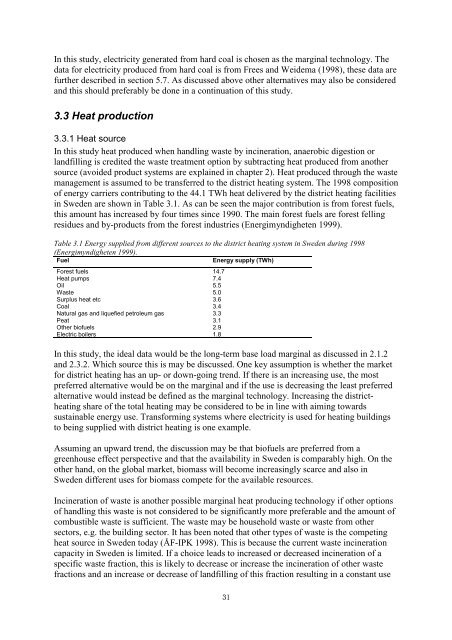Life Cycle Assessments of Energy From Solid Waste (PDF)
Life Cycle Assessments of Energy From Solid Waste (PDF)
Life Cycle Assessments of Energy From Solid Waste (PDF)
You also want an ePaper? Increase the reach of your titles
YUMPU automatically turns print PDFs into web optimized ePapers that Google loves.
In this study, electricity generated from hard coal is chosen as the marginal technology. The<br />
data for electricity produced from hard coal is from Frees and Weidema (1998), these data are<br />
further described in section 5.7. As discussed above other alternatives may also be considered<br />
and this should preferably be done in a continuation <strong>of</strong> this study.<br />
3.3 Heat production<br />
3.3.1 Heat source<br />
In this study heat produced when handling waste by incineration, anaerobic digestion or<br />
landfilling is credited the waste treatment option by subtracting heat produced from another<br />
source (avoided product systems are explained in chapter 2). Heat produced through the waste<br />
management is assumed to be transferred to the district heating system. The 1998 composition<br />
<strong>of</strong> energy carriers contributing to the 44.1 TWh heat delivered by the district heating facilities<br />
in Sweden are shown in Table 3.1. As can be seen the major contribution is from forest fuels,<br />
this amount has increased by four times since 1990. The main forest fuels are forest felling<br />
residues and by-products from the forest industries (Energimyndigheten 1999).<br />
Table 3.1 <strong>Energy</strong> supplied from different sources to the district heating system in Sweden during 1998<br />
(Energimyndigheten 1999).<br />
Fuel<br />
<strong>Energy</strong> supply (TWh)<br />
Forest fuels 14.7<br />
Heat pumps 7.4<br />
Oil 5.5<br />
<strong>Waste</strong> 5.0<br />
Surplus heat etc 3.6<br />
Coal 3.4<br />
Natural gas and liquefied petroleum gas 3.3<br />
Peat 3.1<br />
Other bi<strong>of</strong>uels 2.9<br />
Electric boilers 1.8<br />
In this study, the ideal data would be the long-term base load marginal as discussed in 2.1.2<br />
and 2.3.2. Which source this is may be discussed. One key assumption is whether the market<br />
for district heating has an up- or down-going trend. If there is an increasing use, the most<br />
preferred alternative would be on the marginal and if the use is decreasing the least preferred<br />
alternative would instead be defined as the marginal technology. Increasing the districtheating<br />
share <strong>of</strong> the total heating may be considered to be in line with aiming towards<br />
sustainable energy use. Transforming systems where electricity is used for heating buildings<br />
to being supplied with district heating is one example.<br />
Assuming an upward trend, the discussion may be that bi<strong>of</strong>uels are preferred from a<br />
greenhouse effect perspective and that the availability in Sweden is comparably high. On the<br />
other hand, on the global market, biomass will become increasingly scarce and also in<br />
Sweden different uses for biomass compete for the available resources.<br />
Incineration <strong>of</strong> waste is another possible marginal heat producing technology if other options<br />
<strong>of</strong> handling this waste is not considered to be significantly more preferable and the amount <strong>of</strong><br />
combustible waste is sufficient. The waste may be household waste or waste from other<br />
sectors, e.g. the building sector. It has been noted that other types <strong>of</strong> waste is the competing<br />
heat source in Sweden today (ÅF-IPK 1998). This is because the current waste incineration<br />
capacity in Sweden is limited. If a choice leads to increased or decreased incineration <strong>of</strong> a<br />
specific waste fraction, this is likely to decrease or increase the incineration <strong>of</strong> other waste<br />
fractions and an increase or decrease <strong>of</strong> landfilling <strong>of</strong> this fraction resulting in a constant use<br />
31
















